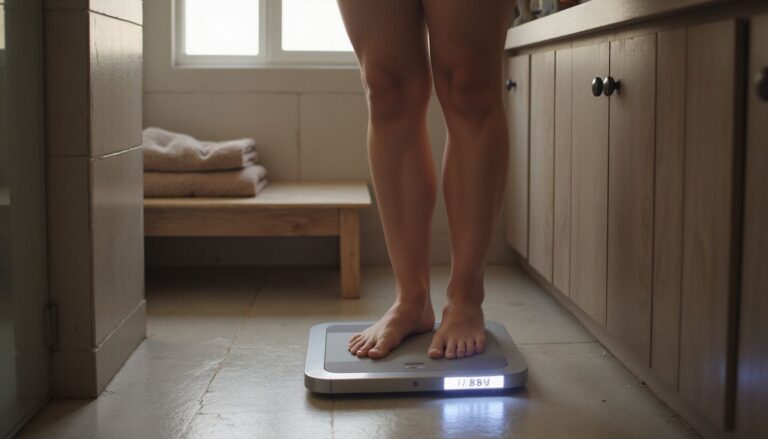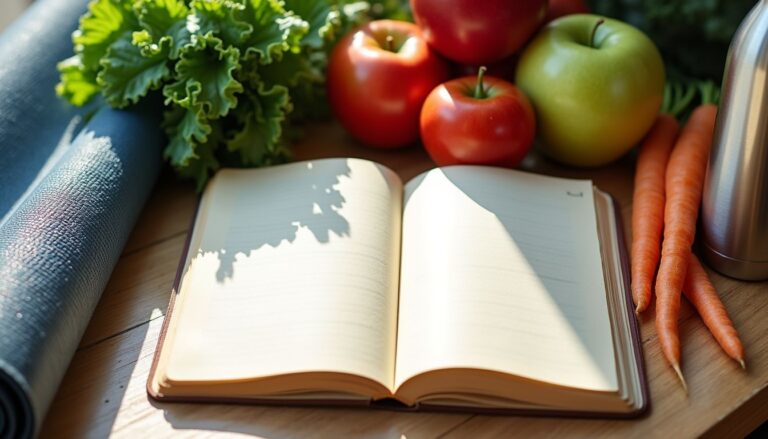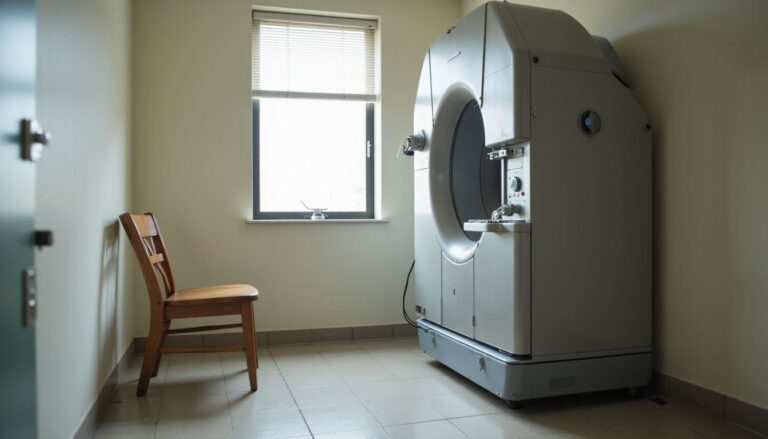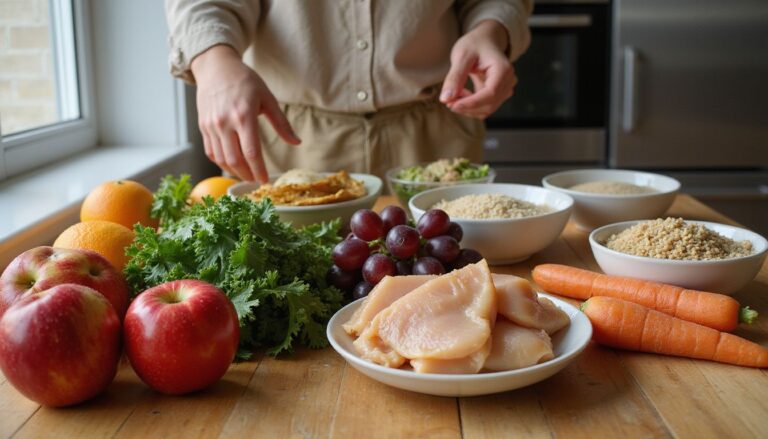7-Day High Blood Pressure Diet Plan: Your Guide To Managing Hypertension With DASH Diet Meals
Our Nutrition Assistant AI Suite will transform your body. You will lose fat, get toned, and build muscle. Gain confidence and optimal health.
If you struggle to keep your blood pressure in a healthy range, you are in good company. About half of American adults live with high blood pressure, which raises the risk for heart disease and stroke.
A proven way to help is the DASH diet, short for Dietary Approaches to Stop Hypertension. This guide walks you through a simple 7-day meal plan that follows expert advice from the National Heart, Lung, and Blood Institute. The menus rely on familiar foods, clear portions, and easy prep.
You will see how these meals can help lower your blood pressure while supporting daily nutrition. Take the first step today with small changes that add up.
Key Takeaways
- About 50% of U.S. adults have high blood pressure, which raises the risk of heart disease and stroke, according to national health organizations.
- The DASH diet helps lower blood pressure by limiting sodium to under 2,300 mg daily, while emphasizing potassium-rich foods like vegetables, fruit, beans, and nuts.
- A 7-day DASH meal plan supports daily intakes near 3,500–5,000 mg potassium and 25–34 grams of fiber, while cutting back on processed foods.
- Research from the National Heart, Lung, and Blood Institute shows that eating fewer saturated fats and more whole grains supports both cholesterol and blood pressure control.
- Dietitians recommend seasoning with herbs, spices, citrus, and vinegar instead of salt to support blood pressure goals in daily meals.
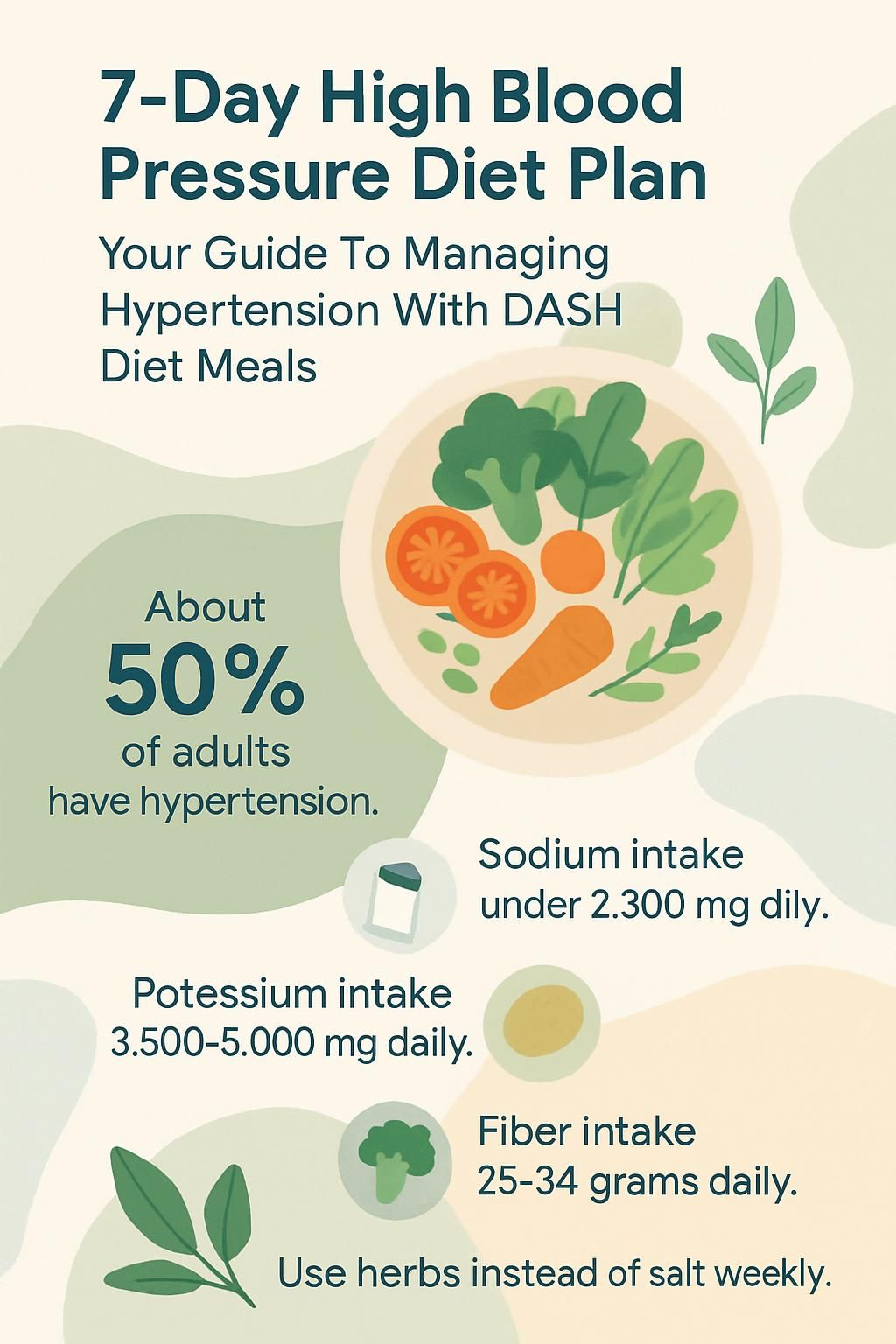
Understanding High Blood Pressure and Diet

Daily eating habits strongly influence blood pressure. Learning how foods raise or lower readings helps you make steady, heart-smart choices.
What is high blood pressure?
Blood pressure measures the force of blood pushing on your artery walls. Doctors diagnose hypertension when the top number, called systolic, is 130 mmHg or higher, or the bottom number, diastolic, is 80 mmHg or higher.
The American College of Cardiology notes that normal blood pressure is below 120/80 mmHg. Uncontrolled high blood pressure increases the risk for heart disease, stroke, kidney problems, and heart attack.
Diets high in sodium, saturated fat, refined grains, or added sugar can raise risk. If several readings are at or above 130/80 mmHg, a healthcare professional may diagnose hypertension using American Heart Association guidance.
How does diet affect hypertension?
Your food choices affect blood pressure every day. Eating lots of salt, processed items, red meat, saturated fat, and added sugars can push numbers higher. Sodium makes your body hold on to extra fluid; this raises pressure on artery walls and strains the heart.
Packaged snacks and fast food make it easy to exceed the 2,300 mg daily sodium limit. Choosing more fruits, vegetables, whole grains like brown rice and quinoa, lean proteins such as fish and poultry, beans, nuts, and seeds increases potassium and magnesium.
These minerals help counter the effects of sodium and support flexible blood vessels. Aiming for at least 25–30 grams of fiber per day can also lower cholesterol and blood pressure. This is why the DASH diet limits sodium and emphasizes nutrient-rich foods that help manage hypertension.
Next, you will see how the DASH pattern works and why it fits a heart-healthy lifestyle.
Overview of the DASH Diet
The DASH diet, which means Dietary Approaches to Stop Hypertension, sets up a heart-healthy eating style for life. It centers on foods rich in potassium, calcium, magnesium, and fiber, and limits sodium and saturated fat.
What is the DASH diet?
DASH was developed by experts at the National Heart, Lung, and Blood Institute. The plan focuses on vegetables, fruits, fat-free or low-fat dairy, whole grains, lean proteins like fish and skinless poultry, nuts, seeds, and healthy oils such as olive or canola oil.
Clinical trials show DASH can prevent and treat high blood pressure. Many people find it realistic because it uses common foods and encourages simple cooking. Water is your main drink; unsweetened tea or coffee can fit if caffeine does not bother you.
To support healthy blood pressure, keep sodium under 2,300 mg per day, as suggested by the Dietary Guidelines for Americans. Some people see greater benefit at 1,500 mg.
What are the key principles of the DASH diet?
These core habits guide your daily choices:
- Reduce sodium to less than 2,300 mg per day; aim for 1,500 mg for greater benefit.
- Fill your plate with vegetables, fruit, whole grains, fat-free or low-fat dairy, beans, fish, and poultry.
- Choose foods high in potassium, calcium, and magnesium. A helpful potassium target is 3,500–5,000 mg daily.
- Limit fatty meats and replace them with fish, skinless poultry, tofu, or legumes.
- Swap full-fat dairy for low-fat or fat-free options.
- Pick vegetable oils, like olive or canola oil, instead of tropical oils such as coconut or palm oil.
- Keep saturated fat below 6% of daily calories, about 13 grams on a 2,000 calorie plan.
- Flavor food with herbs, spices, vinegar, and citrus instead of salt. Choose water or unsweetened drinks rather than sugary beverages.
Benefits of the DASH Diet for Hypertension
DASH helps manage high blood pressure with balanced nutrition and smart ingredient choices. Evidence shows wide benefits for heart and overall health.
How does the DASH diet lower blood pressure?
DASH lowers blood pressure by emphasizing potassium, calcium, and magnesium while keeping sodium in check. Many produce items are rich in potassium. For example, cooked beet greens have about 1,300 mg per cup, sweet potatoes about 570 mg per cup, and a medium banana about 450 mg.
A daily potassium range of 3,500–5,000 mg helps balance fluid and supports normal pressure. Cutting sodium reduces fluid retention, which lowers pressure on artery walls. Many people do well at 2,300 mg sodium per day. Some see even better results at 1,500 mg.
Fiber matters too. Increasing fiber by just five grams a day can improve readings. Aim for 25–28 grams per day for most women under 50, and 31–34 grams for most men under 50. Limiting red meat, sweets, added sugars, and foods high in saturated fat also helps.
How does the DASH diet support heart health?
High blood pressure can damage arteries and raise the risk for cardiovascular disease. DASH supports healthy cholesterol and triglyceride levels and helps improve blood flow.
Whole grains, beans, fruits, and vegetables bring fiber that can lower LDL cholesterol. Keeping saturated fat below 6% of daily calories offers more protection. The plan favors unsaturated fats from olive oil, nuts, seeds, avocado, and fatty fish.
Colorful produce adds antioxidants that support blood vessels. If you do not eat oily fish several times per week, ask your clinician if an omega-3 supplement is right for you. Limiting alcohol can also support healthy blood pressure.
Can the DASH diet help with weight management?
DASH supports weight control because it limits added sugars and highly processed foods. That helps lower excess calories. High-fiber foods like vegetables, beans, and whole grains promote fullness and reduce frequent snacking.
Many 7-day plans offer about 2,000 calories or less, which fits common goals. I noticed steady progress after swapping a salty lunch for a bean and veggie salad. Snacks felt less tempting once fiber increased at meals.
If you want personal guidance, a registered dietitian can tailor portions and recipes to your needs.
Key Dietary Changes to Manage High Blood Pressure
Targeted changes can support blood pressure and help prevent or treat hypertension. The following shifts bring quick wins you can build on.
How can reducing sodium intake help manage blood pressure?
Lower sodium helps your body release excess fluid. Less fluid means less pressure on blood vessels. DASH suggests staying below 2,300 mg of sodium daily; the American Heart Association’s ideal limit is 1,500 mg.
Most excess sodium comes from packaged and restaurant foods. Limit deli meats, canned soups, and salty snacks. Choose fresh ingredients more often, and season with herbs, spices, garlic, citrus, and vinegar.
I replaced a lunchmeat sandwich with a bean and vegetable salad and cut more than 600 mg of sodium in one meal. Sample menus often land near 1,500–2,000 mg per day, which supports healthy blood pressure.
Why should I increase potassium-rich foods?
Potassium helps your kidneys remove extra sodium, which lowers blood pressure. The DASH meal plan encourages 3,500–5,000 mg per day.
High potassium choices include cooked beet greens, sweet potatoes, bananas, guava, and kiwi. Beans, lentils, leafy greens, and soy foods are also strong picks. Some sample days reach 4,000–5,000 mg of potassium through meals and snacks.
If you have kidney disease or take certain medications, talk with your clinician before raising potassium intake.
What are the best lean proteins and healthy fats for hypertension?
Lean proteins support heart health without adding much saturated fat. Good options include salmon, trout, skinless chicken, beans, lentils, tofu, and edamame. A dinner with 4 ounces of salmon or 3 ounces of chicken fits well.
For healthy fats, use small amounts of olive oil, enjoy avocado, and add nuts or seeds. Try to keep saturated fat near 13 grams per day on a 2,000 calorie plan. Avoid fatty cuts of red meat, processed meats, and full-fat dairy most of the time.
If you rarely eat fatty fish, ask your healthcare provider about an omega-3 supplement.
How do whole grains and fiber impact blood pressure?
Whole grains like oatmeal, brown rice, whole-wheat pasta, and farro add steady energy and fiber. Fiber supports healthy cholesterol levels and better blood flow. Many DASH days include at least one high-fiber choice per meal.
Common targets are 25–28 grams of fiber per day for most women under 50 and 31–34 grams for most men under 50. I saw my numbers improve after swapping white bread for whole-wheat toast and choosing brown rice instead of white rice for dinner.
High-fiber meals also boost fullness, which can support calorie control without extra effort.
7-Day DASH Diet Meal Plan for High Blood Pressure
This 7-day plan supports heart health and steady energy. Each day balances protein, fiber, and produce to help you meet nutrition goals and manage sodium.
Day 1: Balanced breakfast, lunch, dinner, and snacks
Breakfast: 1 cup unsalted oatmeal, 1/4 cup raisins, 1 medium banana, and 1 cup fat-free milk.
Lunch: 1/2 cup hummus with red pepper slices, cucumber, 10 baby carrots, three small baked falafel patties, and 1 whole-grain pita.
Dinner: 4 ounces roasted salmon with light maple balsamic glaze, 1 cup wild rice blend, and 3/4 cup green beans with red bell peppers. Dessert: 1/2 cup canned pear slices in juice.
Snack: Low-fat yogurt with a fresh peach.
This day keeps sodium reasonable and delivers abundant potassium, calcium, and magnesium from produce, dairy, whole grains, and fish.
Day 2: Heart-healthy meals and snacks
Breakfast: 1 cup mixed fruit such as melon and grapes, 1/2 whole-wheat bagel with 1 tablespoon natural peanut butter, and 1 cup skim milk.
Lunch: Spinach salad with 3 cups spinach, 1 sliced pear, 1/2 cup mandarin oranges, a drizzle of red wine vinegar and olive oil, 1 ounce goat cheese, 3 ounces grilled chicken, and 1 small whole-wheat roll.
Dinner: Whole-wheat pasta with 1/2 cup marinara, chopped summer squash, and thawed spinach. Serve with melon slices and skim milk.
Snack: Unsalted trail mix with nuts and seeds.
This day stays low in sodium while providing potassium, calcium, magnesium, and about 1,700–1,800 calories for many adults.
Day 3: High-fiber and low-sodium choices
Breakfast: 1 medium avocado and 1 poached egg on whole-wheat toast, 1/4 cup sun-dried tomatoes, and 1 medium orange.
Lunch: Tuna salad made with 3 ounces low-sodium canned tuna, diced onion, bell pepper, celery, and 1 tablespoon light mayo. Serve with 8 melba toast crackers and 1 apple. Drink 1/2 cup skim milk.
Dinner: Vegetable stir-fry with onions, red bell peppers, mushrooms, broccoli, carrots, ginger, garlic, a small splash of mirin, 1/2 teaspoon sesame oil, and a small amount of reduced-sodium soy sauce. Top with cashews and serve over brown rice.
Snacks: 1 peach and a small handful of almonds.
This day highlights fiber and potassium while keeping sodium near 1,400–1,500 mg. It is flavorful without relying on salt.
Nutritional Breakdown:
- Calories: 2,114 kcal
- Fat: 74 g, Saturated fat: 12 g
- Sodium: 1,462 mg
- Potassium: 5,406 mg
- Magnesium: 579 mg
- Calcium: 1,333 mg
- Protein: 96 g
High-fiber meals can improve cholesterol and support blood pressure, which aligns with DASH research.
Day 4: Antioxidant-rich meals for heart health
Breakfast: Scrambled eggs with spinach and tomatoes.
Lunch: Chicken salad with mixed greens and berries. Berries provide vitamin C and flavonoids that support heart health.
Dinner: Baked salmon with steamed broccoli and quinoa. Salmon offers omega-3 fats, while broccoli and quinoa add fiber and minerals.
Snacks: Greek yogurt with mixed berries, chia pudding with fruit, or a small handful of walnuts.
Season with herbs, spices, citrus, and vinegar. Choose low-fat dairy and avoid heavily processed foods to keep sodium in check.
Day 5: Potassium-packed foods for balance
Breakfast: Oatmeal topped with sliced banana and walnuts. A medium banana has about 450 mg potassium.
Lunch: Lentil soup with diced sweet potato and spinach. One cup of sweet potato adds about 570 mg potassium.
Dinner: Grilled chicken with roasted beet greens and brown rice. A cooked cup of beet greens can top 1,300 mg potassium.
Snacks: Orange slices and a small baked sweet potato.
These meals help you reach the 3,500–5,000 mg daily potassium range while keeping sodium controlled.
Day 6: Lean proteins and whole grains focus
Breakfast: Veggie omelet with egg whites, spinach, and tomato. Serve with whole-grain toast.
Lunch: Tuna salad made with celery and Greek yogurt, plus a side of quinoa.
Dinner: Baked cod with lemon, wild rice, and steamed green beans.
Snacks: Low-fat cottage cheese with pineapple, or a small handful of almonds.
This day keeps calories moderate while centering meals on lean proteins and whole grains. Balanced plates help manage sodium without losing flavor.
Day 7: Wrapping up with a nutrient-rich day
Breakfast: Greek yogurt parfait with berries and chia seeds.
Lunch: Whole-wheat pasta salad with chickpeas, red bell peppers, and spinach.
Dinner: Grilled salmon with farro and roasted asparagus.
Snacks: Fresh fruit such as kiwi or guava, plus a small serving of unsalted trail mix.
Water remains your main drink. Leftovers keep prep easy and help you stay on track with potassium, magnesium, calcium, and fiber goals.
Sample DASH Diet Recipes
These simple recipes show how the DASH pattern uses whole ingredients with minimal sodium and smart portions.
What are some easy DASH diet breakfast recipes?
Try oatmeal with banana and raisins for a quick, high-fiber start. Scrambled eggs with spinach and tomatoes deliver protein and antioxidants with little sodium.
Make a Greek yogurt parfait with berries and chia seeds for calcium and fiber. Avocado toast with a poached egg and an orange adds healthy fats and vitamin C.
A half whole-wheat bagel with peanut butter and fruit works well on busy mornings. Chia pudding with mixed fruit is another make-ahead, high-fiber choice.
What are healthy DASH diet lunch ideas?
Build a spinach salad with pear, mandarin oranges, goat cheese, grilled chicken, and a whole-wheat roll. Spinach contributes magnesium and potassium.
Try chicken salad over mixed greens with fresh berries for antioxidants. Make tuna salad with low-sodium tuna, chopped celery, and Greek yogurt. Add quinoa for longer-lasting energy.
A whole-wheat pasta salad with chickpeas, red bell peppers, and spinach is a fiber-rich plant option. Lentil soup with sweet potato and spinach offers potassium and protein.
For a meatless pick, bake falafel and serve it in whole-grain pita with hummus, cucumber, and grape tomatoes. Grilled vegetable wraps with hummus also fit the DASH pattern well.
How to prepare DASH diet dinners like grilled salmon?
Season salmon fillets with black pepper, garlic powder, and a light drizzle of olive oil. Add a thin maple balsamic glaze if you like sweetness without salt.
Grill or bake at 400°F for 12–15 minutes until the fish flakes. Pair with wild rice or farro and a side of steamed green beans or roasted asparagus. Finish with lemon wedges, fresh herbs, and a splash of vinegar for bright flavor.
This dinner fits DASH guidance by combining lean protein, vegetables, and whole grains, while keeping sodium modest.
What are good DASH diet snack options?
Pick snacks that are low in sodium and high in nutrients. Low-fat yogurt with fruit supplies calcium and protein. Unsalted trail mix offers healthy fats and magnesium.
Fresh fruit such as apples, peaches, or berries adds fiber and vitamin C. Chia pudding with berries boosts fiber and omega-3 fats.
Try cottage cheese with pineapple for a protein and calcium combo. A small handful of almonds or walnuts adds crunch and heart-friendly fats. Air-popped popcorn or baked sweet potato chips provide a lighter crunchy choice.
Tips for Meal Prepping the DASH Diet Plan
Planning ahead keeps healthy choices within reach. A short prep session can set you up for the week.
How do I plan a grocery list for the DASH diet?
Start with vegetables like spinach, broccoli, bell peppers, and carrots. Add fruit such as bananas, oranges, berries, and apples for potassium and fiber.
Choose whole grains like oatmeal, brown rice, whole-wheat bread, and quinoa. Buy low-fat or fat-free dairy, such as skim milk and yogurt.
Include lean proteins: skinless poultry, fish, beans, lentils, tofu, and unsalted nuts. Stock herbs and spices to replace salt. Limit fatty meats, full-fat cheese, pastries, and soda.
Reading labels helps you spot hidden sodium. A little planning keeps meals both tasty and heart-friendly.
What are the best ways to prepare meals in advance?
Batch-cook staples like brown rice, quinoa, roasted vegetables, and grilled chicken. Use high-potassium foods such as spinach and sweet potatoes in grain bowls or casseroles.
Chop herbs and pre-measure low-sodium seasonings for quick use. Portion snacks like berries, unsalted nuts, and low-fat yogurt for grab-and-go options.
Cook proteins and grains ahead of time and store in airtight containers. These steps save time and make it easier to stick to sodium and portion goals.
How should I store meals for convenience?
Use airtight containers to lock in flavor and protect food quality. Label each container with the date and contents to track freshness.
Keep a mix of meals in the fridge and freezer, such as soups, cooked grains, and pre-cut vegetables. Having ready options reduces stress on busy days and supports healthier choices.
Common Questions About the DASH Diet
Clear answers help you decide how to use this plan in daily life. Here are responses to frequent questions.
Is the DASH diet suitable for everyone?
DASH is safe and effective for many people, especially those at risk for heart disease or with high blood pressure. It highlights fruits, vegetables, whole grains, lean proteins, and low-fat dairy while limiting sodium.
Some people need adjustments. If you have kidney problems, you may need to limit certain high-potassium foods, such as bananas and potatoes. Speak with your healthcare provider before you start any new meal plan, especially if you have medical conditions or take medication.
Can the DASH diet help with weight loss?
Yes. DASH supports weight loss by focusing on fiber-rich foods and cutting back on added sugars and processed items. Fiber boosts fullness and makes portion control easier.
When I swapped chips for carrots with hummus, afternoon cravings dropped. For best results, pair DASH with regular activity and personalized guidance from a clinician or registered dietitian.
What foods should I avoid on the DASH diet?
Limit foods that raise sodium or add unhealthy fats:
- Fatty cuts of red meat and processed meats like bacon and sausage
- Full-fat dairy products
- Tropical oils such as coconut oil and palm oil
- Processed foods and salty snacks like canned soups, frozen dinners, and chips
- Sweets and sugar-sweetened drinks
- Refined grains such as white bread, when whole-grain options are available
Choosing whole foods and limiting packaged items helps you stay within sodium and saturated fat targets.
Long-Term Benefits of Following the DASH Diet
Over time, DASH can help lower the risk of diabetes, stroke, and some cancers. Many people report lasting habits after a few months of steady practice.
How does the DASH diet support a heart-healthy lifestyle?
Fruits, vegetables, whole grains, lean proteins, and low-fat dairy form the base of DASH. These deliver fiber, potassium, calcium, and magnesium that support normal blood pressure.
Daily sodium limits of 2,300 mg, or 1,500 mg for greater benefit, reduce strain on the heart. More potassium from foods like spinach and bananas helps your body clear extra sodium.
Whole grains can improve cholesterol and stabilize blood sugar. Healthy fats from nuts and seeds replace saturated fats from processed foods and fatty meats.
When I tracked meals at home and cooked with less salt, my resting blood pressure dropped within a few weeks.
Can the DASH diet reduce the risk of chronic diseases?
Yes. Studies link the DASH pattern to lower risks of heart disease and stroke. Eating more fruits, vegetables, whole grains, and lean proteins while limiting saturated fats and added sugars supports long-term health.
A potassium intake near 3,500–5,000 mg per day supports blood pressure control. Fiber from these foods helps protect arteries and improve cholesterol. For tailored advice, consult your healthcare provider or a registered dietitian.
Conclusion
You now have a practical 7-day DASH diet meal plan to help manage high blood pressure. The plan keeps sodium in check, boosts potassium, and builds meals from whole foods that fit real life.
Start with small steps, such as swapping one salty food for a fresh option. Track how you feel and note changes in energy, fullness, and blood pressure readings over time.
This guide is educational and does not replace medical care. Talk with your clinician if you have health conditions or take medication. With steady effort and smart choices, the DASH diet can help you lower blood pressure and support long-term heart health.
FAQs
1. What is the DASH diet and how does it help manage high blood pressure?
The Dietary Approaches to Stop Hypertension (DASH) eating plan focuses on foods rich in potassium, calcium, and magnesium. These nutrients help control blood pressure. Studies show that following this meal pattern can lower systolic readings by up to 11 points for some adults.
2. Which foods should I include in a 7-day high blood pressure diet plan?
A weekly menu for hypertension management includes fruits like oranges and bananas; vegetables such as spinach and broccoli; whole grains including brown rice or oats; lean proteins like poultry or fish; low-fat dairy products; nuts and seeds. Limiting sodium intake is also important.
3. How much sodium should I consume each day with the DASH approach?
Experts recommend limiting daily salt intake to less than 2,300 milligrams for most people using this dietary method. Some individuals may benefit from reducing their consumption further to about 1,500 milligrams per day if advised by a healthcare provider.
4. Can you share an example of success with the DASH meal plan?
After my doctor suggested trying this structured eating style, I followed a seven-day schedule focused on fresh produce, lean meats, and reduced-salt options at every meal time. Within two weeks my average blood pressure dropped noticeably according to home monitoring records.
Summary: The DASH strategy uses nutrient-rich ingredients while restricting salt content to support healthy blood flow levels over time. Research supports its effectiveness when applied consistently through balanced meals tailored for those managing hypertension symptoms or risks.[1][2]


